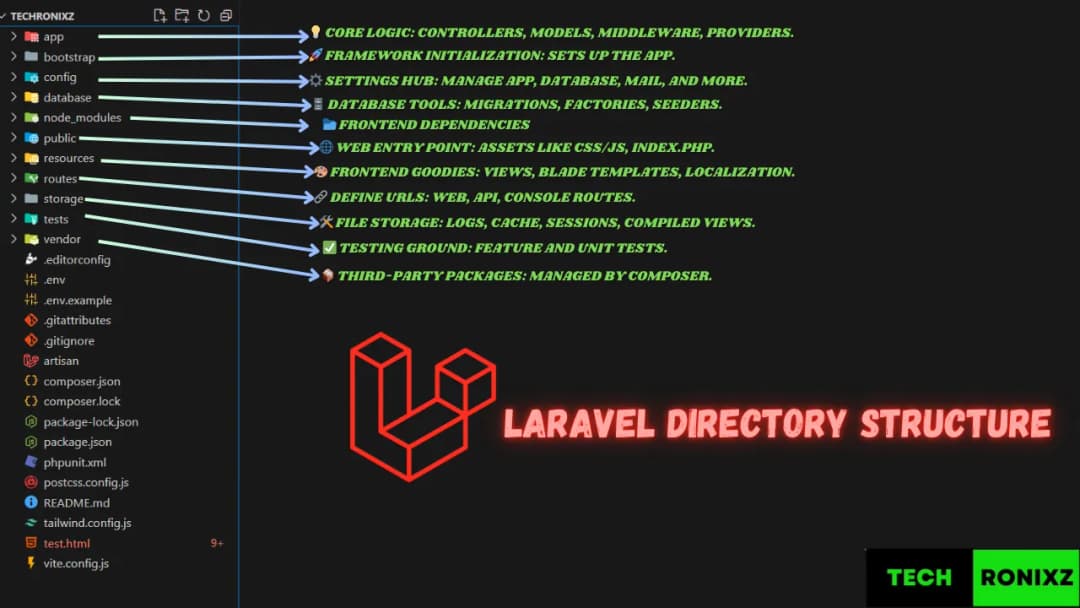Understanding Laravel Directory Structure: A Beginner’s Guide
Laravel is one of the most popular PHP frameworks today, celebrated for its elegant syntax, robust features, and ease of use. However, for newcomers, understanding the Laravel directory structure can seem daunting. This guide simplifies the Laravel folder system, making it easy to grasp even for someone with basic coding knowledge. Let's dive in and explore how Laravel organizes its files and why this structure is beneficial.

Why Does Laravel Have a Specific Directory Structure?
Laravel follows the Model-View-Controller (MVC) architectural pattern. This structure separates business logic, user interface, and data handling into different layers. Such organization:
- Keeps your code clean and modular.
- Makes debugging easier.
- Supports scalability for larger applications.
Understanding the directory structure helps you harness Laravel's full potential, whether you're building a small blog or a large-scale e-commerce application.
Laravel Directory Structure: The Breakdown
When you create a new Laravel project, you'll see several folders and files. Here's what each directory does:
1. Root Directory
Key files at the top level:
artisan: Laravel’s CLI for running commands like migrations or cache clearing..env: Environment-specific configs (e.g., DB credentials, API keys).composer.json: Manages PHP dependencies via Composer.
2. app/
The heart of your application:
Console/: Custom Artisan commands.Exceptions/: Error handling logic.Http/: Controllers, middleware, and form requests.Models/: Eloquent models for database interaction.Providers/: Service providers that bootstrap the app.
3. bootstrap/
Initializes the framework. Contains app.php, which creates the Laravel application instance.
4. config/
All configuration files live here—database.php, mail.php, cache.php, etc.
5. database/
Database-related files:
migrations/: Version-controlled schema changes.factories/: Generate fake data for testing.seeders/: Populate the database with initial data.
6. public/
The web-accessible root of your app:
index.php: Entry point for all requests.- CSS, JS, images, and other public assets.
Only this folder should be exposed by your web server.
7. resources/
Frontend and view-related files:
views/: Blade templates.lang/: Localization files.css/,js/: Source files for assets (often compiled via Vite).
8. routes/
Defines application endpoints:
web.php: Web routes with session state.api.php: Stateless API routes.console.php: Artisan command definitions.channels.php: Broadcast channel authorization.
9. storage/
Stores generated files and logs:
app/: User uploads.framework/: Cache, sessions, compiled views.logs/: Application logs (e.g.,laravel.log).
⚠️ This directory must never be publicly accessible.
10. tests/
Laravel encourages testing:
Feature/: Integration tests (routes, APIs).Unit/: Isolated class/method tests.
11. vendor/
Managed by Composer. Contains all third-party packages. Never edit files here manually.
Best Practices for Using Laravel’s Directory Structure
1. Organize Your Code Wisely
Keep controllers thin. Move complex logic to service classes, repositories, or domain-specific classes. This improves testability and reuse.
2. Secure Sensitive Files
Ensure .env and storage/ are not web-accessible. Use proper server configuration (e.g., Nginx location blocks or Apache .htaccess rules).
3. Leverage Artisan Commands
php artisan make:controller PostController
php artisan make:model Post -mf
php artisan make:middleware EnsureUserIsAdminThese commands auto-generate files in the correct directories with proper boilerplate.
4. Follow MVC Principles
Keep business logic in models or services—not in views or controllers. This separation makes your codebase cleaner and easier to maintain.
Conclusion
Understanding Laravel’s directory structure is essential for anyone serious about web development. By mastering this, you can write cleaner, more maintainable code and unlock Laravel's full capabilities. Whether you’re building a simple blog or a complex enterprise application, Laravel’s thoughtfully designed structure has you covered.
So, what are you waiting for? Open your Laravel project and start exploring its directories today!
Frequently Asked Questions
Related Articles You May Like
- How to Become Web Developer: Essential Guide for Success
Career • Beginner
- How to Start Blogging on WordPress: A Step-by-Step Guide
WordPress • Beginner
- Master Git: 10 Essential Commands Every Developer Should Learn
Git • Beginner
- Laravel API Example: Creating Efficient Endpoints
Laravel • Advanced
- Laravel Tips and Tricks: Hidden Features Most Developers Miss
Laravel • Advanced
- How to Debug Laravel SQL Queries in API Requests: A Developer's Guide
Laravel • Intermediate